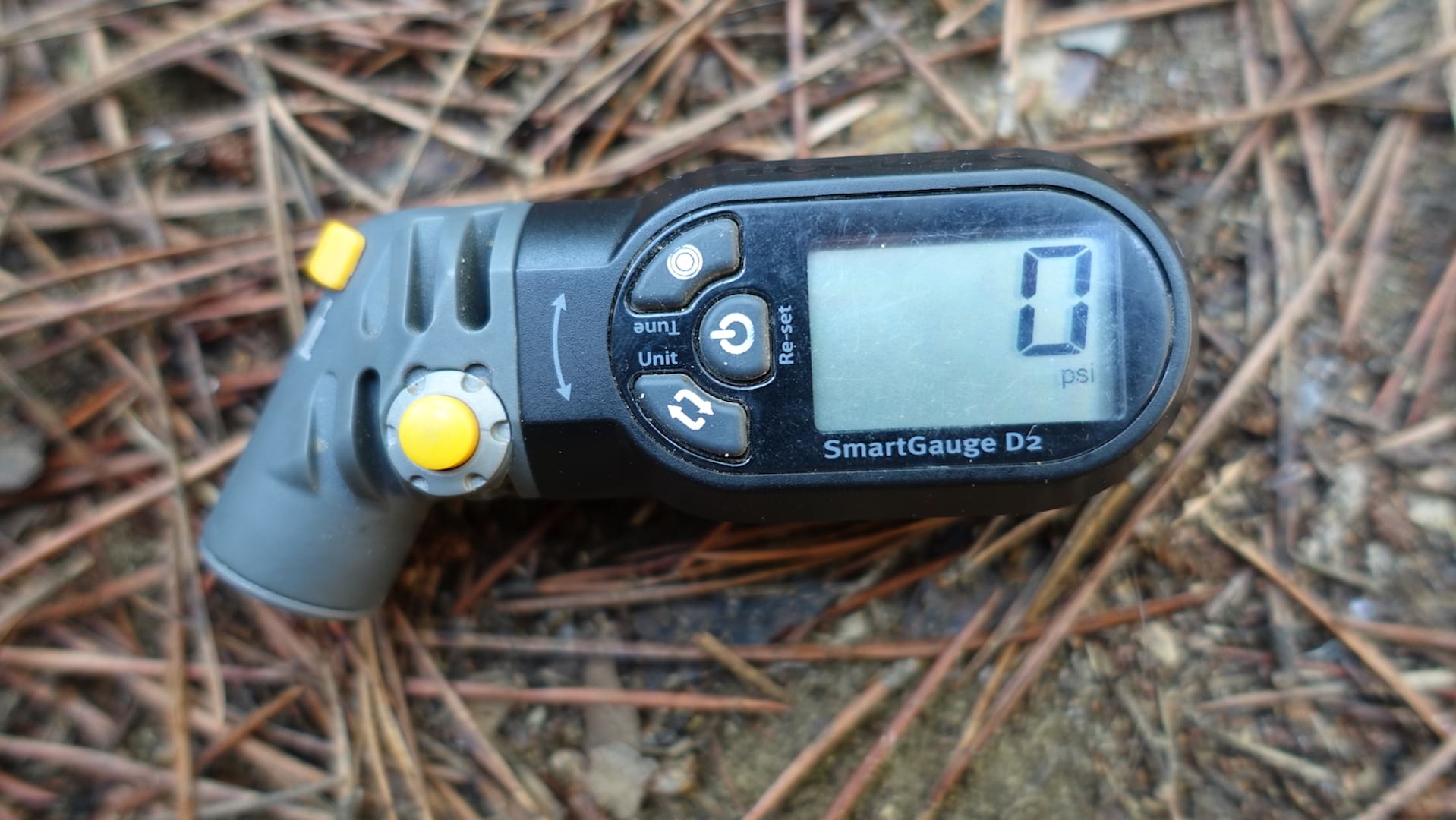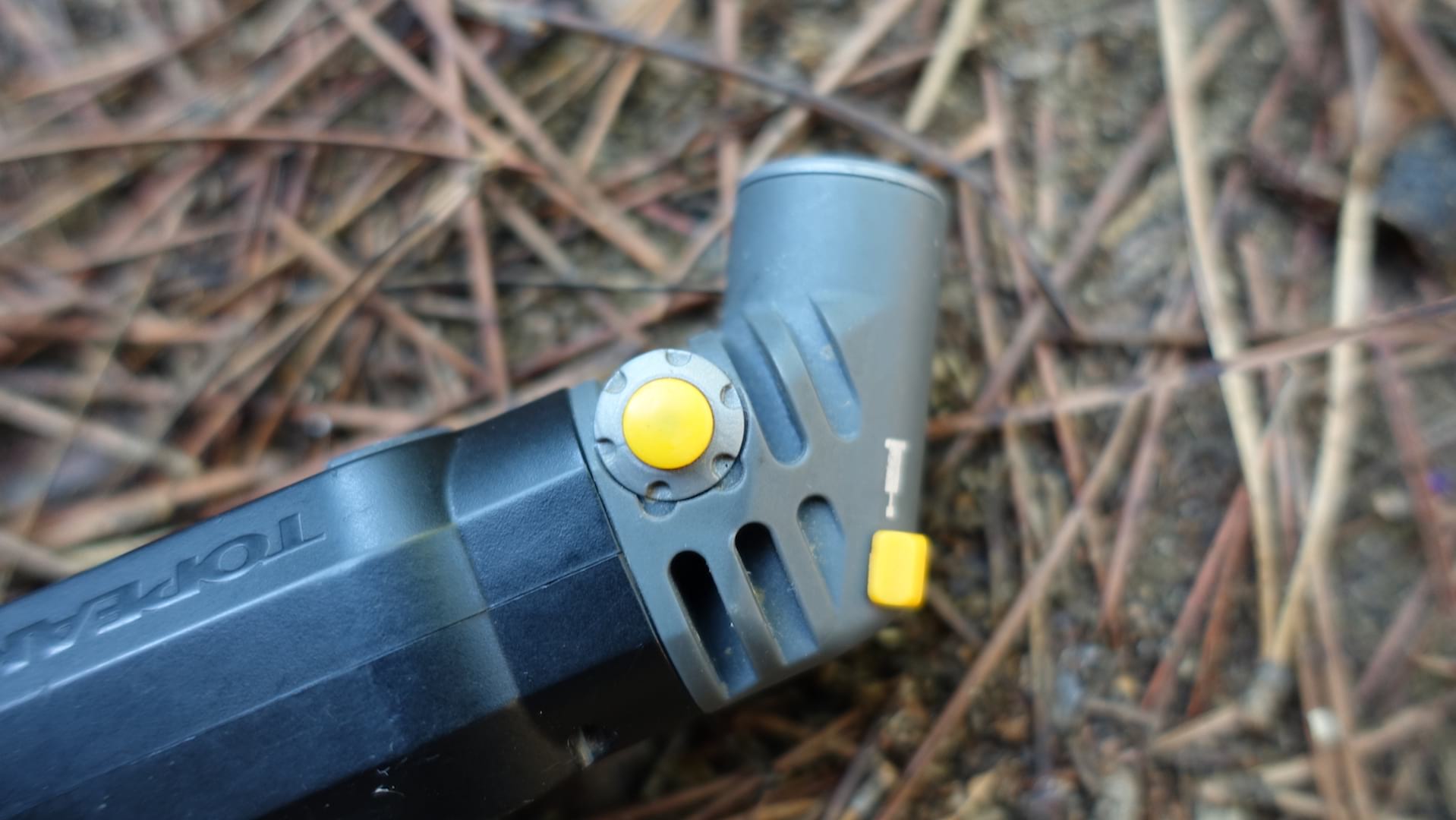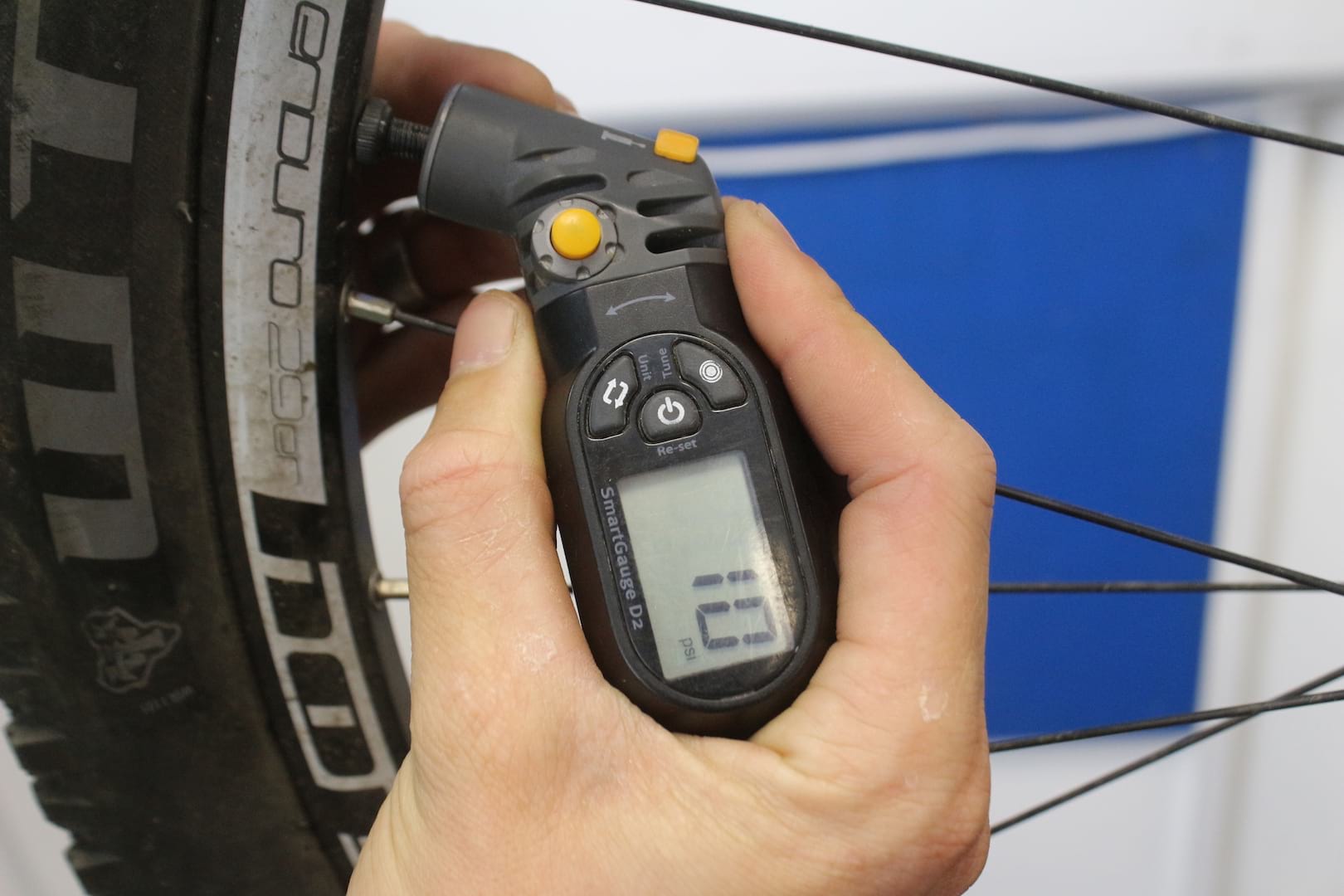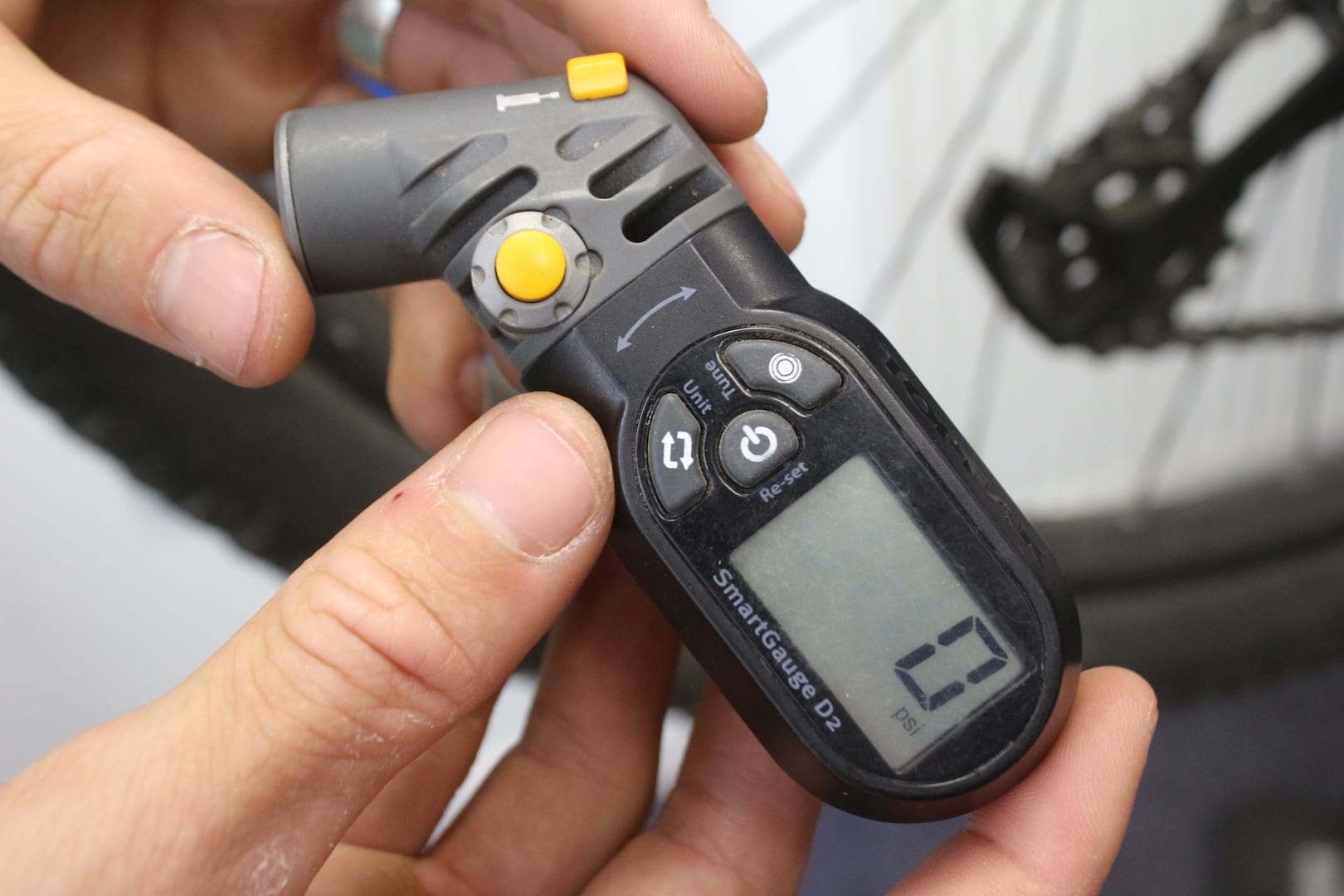Just how important is it to set your tyres to the right pressure? According to Wil, it is VERY important, and it can make a huge difference to how your bike rides on the trail. In a quest to find the best tool for the job, Wil and the gang have tested out six different tyre pressure gauges. Next up is the Smart Gauge D2 from Topeak.
With its enormous catalogue of pumps, tools and accessories, it’s no surprise that Topeak was one of the first bicycle brands to offer a dedicated standalone pressure gauge. This first gauge was an analogue tyre and suspension pressure gauge called the Shuttle, which is a lovely piece of equipment – not unlike the EVT Bleedin’ Gauge with its large analogue dial. Since the Shuttle offers a 0-300psi range though, it was difficult to utilise at the lower pressures necessary for a mountain bike tyre.
Not long afterwards, Topeak launched a digital version called the Smart Gauge, which was then superseded by this one; the Smart Gauge D2. It’s been in the Topeak range for a good while now – I actually owned one of these nearly a decade ago, where it became a staple in my tool kit, and the current version remains unchanged.

Using a plastic body with a digital LCD display and a replaceable CR2032 battery, the Smart Gauge is compact and lightweight at 95g, and it fits neatly in the hand too. There’s a 180° swivel ‘Smart Head’ with a sliding yellow lever for you to select between Presta or Schrader valves. Topeak also says you can use it with air-sprung forks and shocks, though personally I’ve only ever used it with tyres.
Latest Singletrack Merch
Buying and wearing our sustainable merch is another great way to support Singletrack
The gauge’s face has an on/off rubber button, and next to it is your unit selector for switching between psi, bar and kg/cm2. Then you have the ‘Tune’ button, which is what you want to use while the gauge is fitted to the tyre. After pressing this button, the display flashes to let you know you’re in the tuning mode. From there you simply push the gauge onto the tyre valve, and the gauge will read the current pressure. You then use the yellow bleed valve to release excess air pressure, and the display will show you a live reading, until you hit your desired pressure.

I like the large display on the Smart Gauge, with nice big digits that are easy to read. The gauge will only read to the nearest whole psi, which may not be quite enough for fat bike riders who run super low pressures and want a more precise reading. Also, in testing against the other gauges, the Smart Gauge was the only one to consistently under-read by around 1 psi. Based on my (and other testers’) prior experience, I’m not convinced this is normal though. Given I’ve had this particular gauge for nearly 18 months now, I suspect that at some point some residue sealant has entered inside the gauge and is causing some issues with accuracy. It’s worth noting that this can happen with any gauge/pump though, and in our test only the EVT gauge features a replaceable filter to address this issue. It is possible to unthread the main seal of the Smart Gauge’s valve head to clean out the brass needle and spring of any dried latex, and while this helped, it still left the gauge under-reading slightly.

Also of note is that Topeak has recently introduced a new gauge called the Shuttle Digital. This isn’t a replacement – it’s an addition to the range, and it is priced higher than the Smart Gauge D2 tested here. It does offer pressure readings down to 0.5psi increments though, and like the Fabric gauge in our test it can also be used in-line with a floor or mini-pump.
Overall
One of the original and still one of the best and easiest-to-use digital pressure gauges on the market. It is a little expensive though, and there are some excellent alternatives from the competition for less money.





If sealant is inside the gauge you can unscrew the grey cap and get at the bits inside to clean them. You can even get the bits as spare parts! It’s built to last and just works.
@mily1980 – That is very good to know – thank you for the head’s up! I’ll crack this one open this afternoon to give it a clean out, and see if that’s what’s going on with it. Stand by!
ST Wil.
Surely it doesn’t really matter if it under-reads compared to other gauges as long as it’s consistent and it’s the gauge you regularly use? I guess it’s a factor if you’re looking to set a basemark that you can replicate repeatedly with other gauges, but for most users, as long as the error is consistent – eg: the gauge always reads 28 psi when the actual pressure is 30psi – it doesn’t really matter, he pointed out pedantically…
@BadlyWiredDog – Absolutely agree with you there! Repeatability is much more important than accuracy.
The only issue is if you’re taking pressure recommendations from other people – their ’28 psi’ might be quite different to your ’28 psi’.
I’ve got a feature article on tyre pressure and some comparative information on the six pressure gauges tested that’ll be published shortly – stay tuned for that one!
ST Wil.
Great little tool. Works great for setting up and tuning air sprug forks and shocks too.
£49.99 …… you can probably by two for that and take the average reading !
@singletrackwil sounds interesting. There’s some interesting stuff going on with plus-sized tyres in particular where the increased volume seems to mean that there’s a relatively narrow window of optimum pressure which, unfortunately, seems to coincide with the optimal window of pinch-flattability, kind of like a high volume / low pressure air shock.
@milky1980 – I took the head of the gauge apart to give it a clean out, and managed to remove a little bit of gunk around the main seal head. That definitely helped, but the gauge is still under-reading by around 1psi, so I’m suspicious that there’s still some residue sealant deeper inside the gauge.
Thanks for the head’s up on that one!
ST Wil.
I’ve one of these, it’s been excellent and consistent throughout. Search around for deals as I paid less than half the £49.99 RRP.
@singletrackwil, “1 ~ 1.5psi may be lost after each pressure measurement” as stated in the manual?
@singletrackwil I recently bought one of these to take on holiday as my track pump is my only other pump with a gauge… Turns out mine significantly under reads compared to 2 track pumps on holiday and my Topeak Joe Blow Mountain. Says 17psi, when others are saying 22. Which is 20% off. While repeatability is more important than accuracy, it’s useless if 2 devices I use disagree. I’m taking it to work to get a proper calibration…